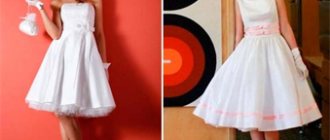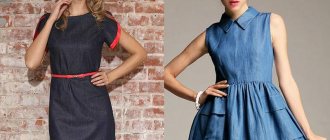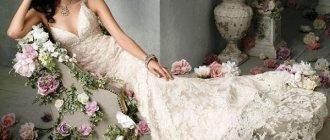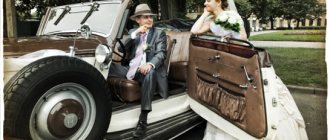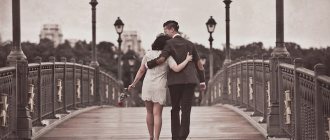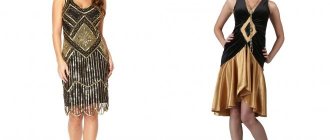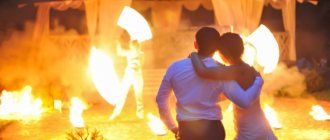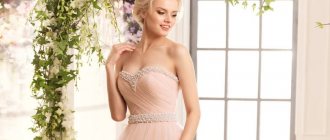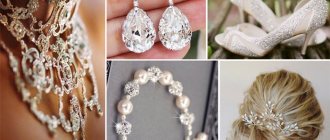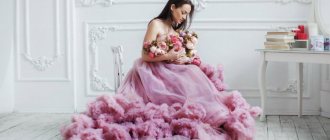Peculiarities
The 20th century is a century of upheavals, radical changes, bold discoveries and rebellion. All this was reflected in fashion – both everyday and wedding:
- After the First World War, women finally abandoned uncomfortable corsets and fluffy starched skirts and allowed themselves to be open and relaxed. This is what defined women's fashion, which began in the 20s of the last century with elegant outfits in the Gatsby style. They are characterized by medium length and rectangular shape;
- In the 30s, fashion turned towards the classics , and dresses again rushed to the floor. They were elegant and accurately followed the contours of the figure;
- In the 40s, the Second World War was going on, and the style became laconic and as simple as possible. Dresses or skirts were complemented by a jacket with square shoulders and became similar to military uniforms;
- In the post-war 50s, women finally had the opportunity to dress beautifully. Dresses of that time had two styles: hourglass or tight-fitting with a strong taper at the bottom;
- In the 60s, the era of dudes began, preferring to look very, very bright , thereby emphasizing carelessness, love of life and positivity. It is precisely this mood that can be seen in the outfits of that time;
- In the 70s, the era of hippies began, preferring simple and loose styles , natural materials and hand-made jewelry.
The whole variety of dresses of the 20th century is the retro style.
Modern variations of a wedding dress in retro style (photo)
The vintage style is so popular that, no matter how paradoxical it may sound, modern variations are created on its basis. We can say that it is not the outfits themselves that are subjected to artificial aging, but the fashion trends of the modern era are attributed to old-fashioned styles. Unusual trends are especially pronounced in wedding fashion and can be called an alternative for those brides who want to look original, but are biased towards old-fashioned things. Let's look at some interesting solutions in this area.
Vintage in Greek style
Outfits that highlight the seductive curves of the body, indicating that this is the majestic goddess of Olympus, but at the same time maintaining a retro mood. Such dresses will fit perfectly into a bohemian setting or will be the best solution for a wedding with a trip to nature. Airy, translucent fabrics and a light semi-fitting silhouette best suit a relaxed pastime.
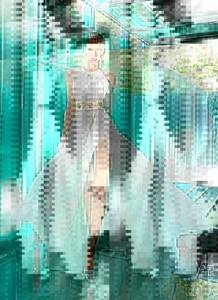
Photo from the site: victoriya-salon.ru
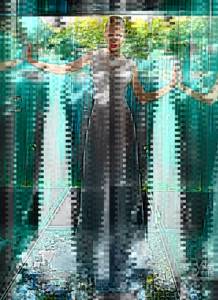
Photo from the site: victoriya-salon.ru
Vintage in Victorian interpretation
The era of Queen Victoria was characterized by outfits that distinguished their owner as a modest and romantic person. At the forefront are outfits with a train, a closed top and a high collar - strictly and rather restrained. But it’s enough to add a light touch of vintage and the bride’s wedding dress will sparkle with mysterious and feminine notes.

Photo from the site: victoriya-salon.ru
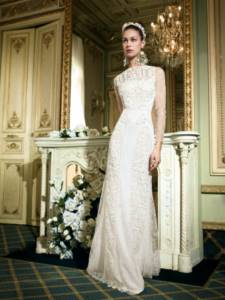
Photo from the site: victoriya-salon.ru
Vintage with a touch of Spanish passion
The national Spanish style in a retro interpretation is an unusual solution for a wedding dress. A chiseled silhouette, multi-layered skirts, an emphasis on the waist and an abundance of lace are an option for brave people who are not afraid of ostentatious extravagance. This dress will give its owner sensuality and fatal passion.

Photo from the site: victoriya-salon.ru
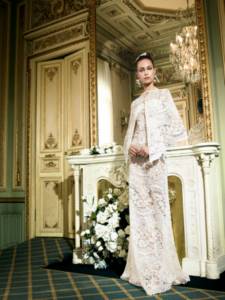
Photo from the site: victoriya-salon.ru
On a note
If you want to create a truly vintage wedding, take care of the bridesmaids’ outfits, inviting them to choose outfits in the style of the era being played out.
Who is it suitable for?
Wedding dresses in retro style are very romantic, and therefore they are suitable for any girl who wants to create a special mood at her own wedding.
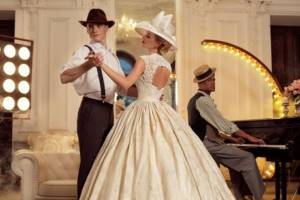
When choosing an outfit, you should rely not only on your personal preferences for a particular time period and its fashion trends, but also take into account your figure, facial features, and type.
For example:
- girls who want to look elegant should pay attention to dresses in the Gatsby style of the 20s;
- those who strive for simplicity and originality will like hippie-style models;
- For those who want to shine in a luxurious look, there are immortal vintage classics.
Colors and shades
Today, the trend is wedding dresses in pastel colors other than white. This trend has not bypassed the vintage direction. Thus, the most favorite colors among brides were pale lavender, sky blue, delicate beige and cream.
Girls who choose a vintage wedding dress do not risk anything. They simply decide to emphasize individuality in this way, while the image turns out to be very restrained and laconic.
The color of the wedding attire determines how the outline of the designer’s planned silhouette will look. For example, even the most understated vintage outfits will look edgier in rich coral colors or bright blues.
Naturally, girls choose them extremely rarely, but it still happens. But the intricate cut and extravagance of the dress can soften the delicate shades of peach or pale pink.
Models – with photos
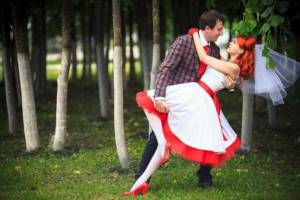
"The Great Gatsby"
While on one continent the kings of smuggled alcohol made a fortune from Prohibition, and on another continent they were recovering from the shocks of the world war, women all over the world gained the opportunity to become more relaxed: not only in their behavior, but also in the choice of chic outfits that were so lacking in the difficult wartime.
In the 20s, the years of dazzling glamor and brilliant jazz, fashion designers abandoned full skirts and confining corsets. Elegant dresses of a loose rectangular cut with a bold neckline, usually on the back, have come into fashion.
Interesting! Modern fashion for dresses of the 20s returned after the release of the film “The Great Gatsby” with the inimitable Leonardo DiCaprio.
Dresses with a rectangular silhouette perfectly hid figure flaws, be it a not too thin waist or a protruding tummy. The aristocracy and sophistication of the image helped to emphasize the neutral shades of noble fabrics: silk, velvet, lace, chiffon. Fringes, precious stones, embroidery, furs or feathers were chosen to decorate dresses.
The following accessories were used:
- pearl beads;
- neckpiece;
- gloves;
- feather boa;
- fur coat;
- a small bucket bag embroidered with stones or beads.
The hairstyle should be complemented by:
- silk scarf;
- mesh veil;
- miniature hat;
- bandages and forehead coverings decorated with pearls, rhinestones, stones and beads, feathers.
Today, brides are offered retro dresses with a rectangular silhouette and low waist in ivory, beige or cream. There should be no emphasis on the waist, and if you don’t want to open your back, then the neckline area should be covered with lace or chiffon. It is better to avoid sleeves. Length - just below the knee.
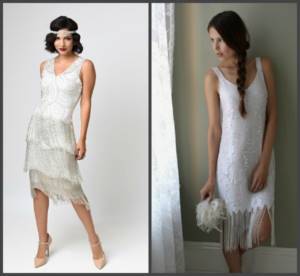
Chicago
The fashion of the 1930s was influenced by the economic crisis and the Great Depression. There was a catastrophic shortage of money, people were fired from factories that were closing everywhere, and therefore most women could not afford chic outfits.
The glamor of the Jazz Age was replaced by understated elegance. The dresses were quite long: ankle-length, and sometimes longer. Very short skirts were not encouraged.
Long dresses with slouchy hips, the style of which later became known as “Chicago,” were very popular. They were made from dense fabrics: satin, silk, velvet or chiffon. Generous drapery or flounces became a characteristic feature. Small hats, fur coats and long gloves were chosen as accessories.
In the 30s, the color of the dress could be any, but for a modern wedding it is better to choose white, ivory, soft pink or cream. This outfit will give your image strict elegance and grace.
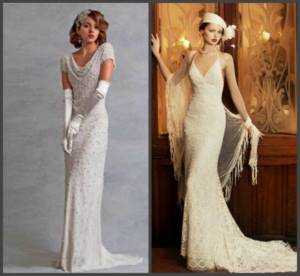
Military 40s
Wartime dictated the strictest economy of resources: the shortage of textiles, which was required for sewing uniforms, led to the fact that the skirts of women's dresses became shorter (to the knees) and narrower. The top of the dress, blouse or jacket seemed to be cut according to the patterns of a military tunic. It was in the 40s that wide square shoulders came into fashion.
To add elegance to the look, resourceful women used accessories - primarily a variety of hats.
Interesting! After the occupation of France, American designers and fashion designers became trendsetters.
Today, wedding dresses in the style of the 40s are a delicate texture of tulle and chiffon, bare shoulders or long sleeves.
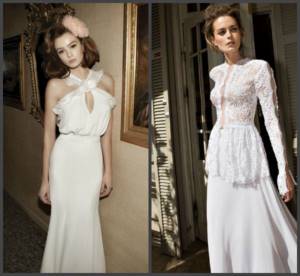
Luxurious 50s
Yearning for color and bold decisions during the years of war restrictions, designers returned bright dresses with a deep neckline and a fluffy short skirt to the catwalks in the 50s. Often, very bold and sexy outfits were worn by busty women with wide hips, because the fashion for thin young ladies with languid eyes had passed.
Preference was given to the hourglass silhouette, which had great advantages:
- the skirt widened at the bottom created the effect of a wasp waist;
- a knee-length or floor-length bell skirt hid wide hips;
- the knee-length made it possible to demonstrate the beauty of the legs;
- The deep neckline emphasized her ample breasts.
Today, wedding dresses in the “new look” style are a multi-layered full skirt, a wasp waist, a corset or open shoulders, and a small hat (or its imitation). If in the 50s the accents of makeup were scarlet lips and black wide eyeliner, then today's brides should choose this option only if they are absolutely sure that it is suitable.
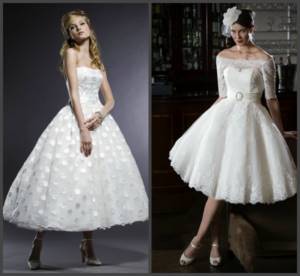
Hipsters
The sixties continued some of the trends of the previous decade and abandoned others. The skirts retained their layering, the belt still focused attention on the thin waist, but the neckline began to disappear (with the exception of the V-shaped neckline on the back).
The color scheme is absolutely free, but the brighter, the more fun it is to boogie-woogie. Geometric prints (especially chic - a skirt with large polka dots with a starched petticoat), bright jewelry, bow headbands on a fluffed up hairstyle, large eyelashes and a doll-like look - the image demanded extravagance, courage, and recklessness.
Today, brides can choose a white dress with a characteristic A-line silhouette and add retro notes to it with bright details : large beads, a high bouffant, a contrasting belt, a fluffy petticoat.
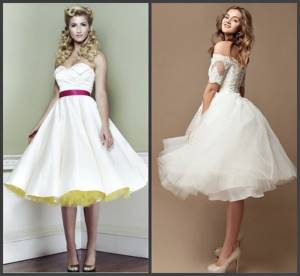
Hippie
Hippie style is a protest against the system, stereotypes and inequality. “Flowers of Life” advocated peace and love, chanting “Make love, not war!”, which literally means “Make love, not war!” The hippie worldview also influenced the formation of a style whose hallmarks were simple silhouettes, unpretentiousness, originality and ethnic motifs.
Hippie clothes are old jeans, without labels or brands, jackets and vests with embroidery or fringe made from natural fabrics.
Interesting! Hippie accessories - baubles, ribbons or thin braided hair cords.
It takes a lot of courage to wear a hippie dress to a wedding. The colors alone are worth it! They can be natural earth tones (brown, green, yellow) or acidic with various psychedelic patterns.
An important point for the hippie look is the hairstyle. For women, this is usually long, flowing hair, sometimes braided or tied into ponytails. Often hippies would braid a thin braid or several, leaving the rest of their hair loose and weaving threads, beads, beads or ribbons into the braids.
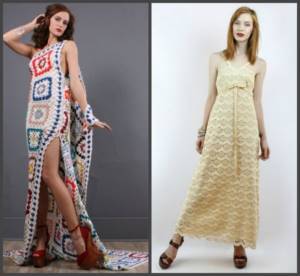
How to complete a retro or vintage wedding look
Well, the dress has been chosen, but that's not so bad! It is also necessary to create a harmonious image so that nothing conflicts with anything, but, on the contrary, creates a thoughtful and original look for the bride.
In order for you to create just such an image, I want to give you some practical recommendations, which are based on my observations of the work of stylists at wedding celebrations:
- Think about your makeup and hairstyle. You have a long and difficult day ahead of you, so you need to choose mega-resistant makeup and hair fixation products. In addition, it is worth holding a rehearsal with a stylist so that you can understand in advance whether you have chosen the right makeup and hairstyle.
- Give your makeup a test drive by crying, getting angry, or sweating. A wedding is such a thing, no one is safe from tears of joy and solemn excitement, but in order for the photographer to be able to capture you from the best angle, it is necessary that the cosmetics remain where they belong.
- Try on your wedding dress in advance in full combat readiness (with makeup, hairstyle and accessories). Look in a large mirror in which you will see yourself in full height. Doesn't the image seem overloaded? Answer this question for yourself. After all, maybe a brooch or a gorgeous peacock feather should be removed from your hair? Or maybe, on the contrary, it’s worth adding something?
- Among all the variety of wedding accessories, the main one is the bouquet and it also has a lot to do. Not all flowers can withstand a long, busy day. Therefore, you need to approach the choice of a bouquet thoroughly so that it can withstand everything - from temperature changes to the moment of its throwing - and at the same time retain its freshness and attractive appearance.
- Contact the professionals of the wedding industry so that they will deprive you of many problems, leaving you with only a slight ceremonial excitement.
Dear girls, share with me and other blog readers, have you ever found yourself in any awkward situations at a wedding related to makeup or outfit? How it was? And how did you end up getting out of this situation? It will be very interesting and useful to hear your stories.
Vintage
Vintage is a fashion trend whose goal is to revive old trends and create stylizations of once popular trends.
Greek
Mediterranean vintage is characterized by lightness and airiness. Greek style dresses are simple and elegant. They are almost always long, made from airy fabrics and have an elegant style, decorated with pleated inserts and belts, and can have an asymmetrical cut.
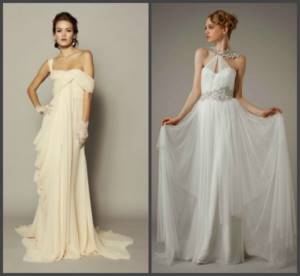
Victorian
Interesting! Queen Victoria, whose name was given to an entire era, became a trendsetter in the field of snow-white wedding dresses.
Characteristic features of Victorian vintage:
- grace;
- wealth;
- luxury;
- romance.
Each subsequent era gave Victorian retro dresses its own characteristics: the 20s - low waist, the 40s - puffed sleeves, hippies - embroidery and folklore motifs. Thus, traditional Victorian dresses with a tight-fitting bodice and a fluffy skirt made of organza, cashmere, silk, and linen were transformed into fitted asymmetrical A-dresses with a long train. Only the color remained unchanged - white or ivory.
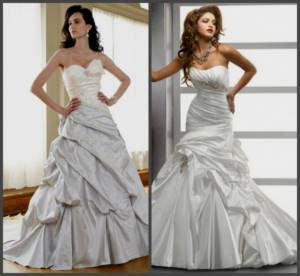
Features of vintage style wedding dresses
Once upon a time, dresses in vintage style were sewn exclusively in one copy. Many craftsmen worked on each of them. As a rule, the work took more than one week and sometimes even months. Craftsmen used the most expensive materials, fittings and decor to sew such exclusive vintage products. Accessories for the vintage dress were selected individually. And the outfit itself had to be ordered, since vintage dresses were not mass-produced.
Today, famous designers dedicate entire collections to vintage wedding dresses. Naturally, the materials used for sewing are not cheap, but certainly not the same as before. The only thing that has remained unchanged in the tailoring of such dresses for brides is their style and certain key points, for example:
- As a rule, it is customary to use airy and flowing fabrics as the basis for sewing vintage wedding dresses. You can often see rhinestones and beads on an outfit as decoration.
- As for the length in vintage, it can be very different. Floor-length models can have a high or low waistline. In versions of short dresses, the waist is in its place.
- The cut of vintage wedding dresses is usually straight and simple. The lower part is often flared at the knees. Sometimes the neckline and back may be open, and the dress may also have a neat train.
A simple cut allows you to create a very elegant and delicate vintage look, while emphasizing all the advantages and hiding figure flaws.
Important! In order to fully preserve the concept of the most important day in life, it is important to take into account that the bride’s dress and the groom’s outfit must match in style and harmoniously combine shades. Vintage elements should be present in the decor of the banquet hall, as well as in the dress code of guests.
Cut and design options
Existing versions of retro wedding dresses are the most successful stylizations of models of the last century, adapted to modern trends.
Sleeveless with bare back
This retro dress design is from the 20s and Gatsby style. The loose, sleeveless silhouette features a completely flat front that contrasts favorably with the deep cutout at the back.
Silk, chiffon, lace, and velvet are used for tailoring. For decoration - precious and artificial stones, pearls, beads, fringe.
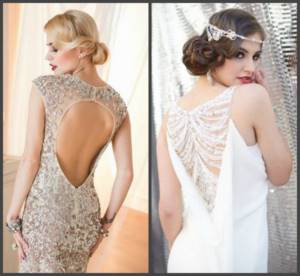
Train and cutout at back
Wedding dresses with long trains and low backs came in a retro style from the 30s. They were made of satin and silk.
A similar cut is also typical for vintage outfits - Greek and Victorian. In the first case, the naked back is decorated with draperies that smoothly turn into a train. In the second, the train “grows” out of the skirt, as it forms a single fabric with it.
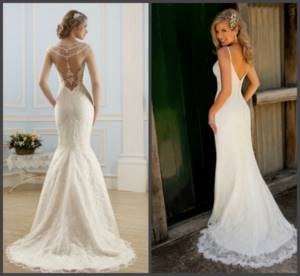
Full skirt and tight top
The A-silhouette is typical for dresses of the 50s and 60s. It is suitable for brides who want to emphasize a graceful waist and hide imperfections in the hips (excessively wide or, on the contrary, too narrow).
Retro wedding dresses of this type are made both from simple fabrics (the designers do not skimp on decor - lace, pearls, rhinestones) and from luxurious fabrics such as satin.
If you're looking for a classic, retro A-line dress for your wedding, opt for a long satin gown in a light shade with a full skirt for an elegant look.
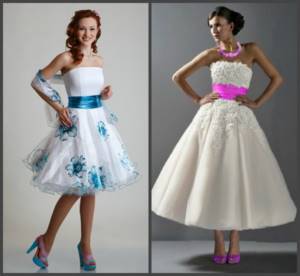
Deep neckline and corset
A retro wedding dress with a deep neckline and a lace-up corset is a reference to the design of the Victorian era, which lost chastity and gained boldness and sex appeal.
Many brides choose this particular design for a wedding dress to emphasize the waist with a corset, open up the neckline and make the silhouette graceful with a long and full skirt.
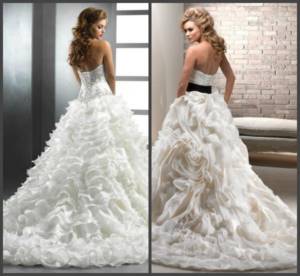
Styles and models
“Mermaid”, “A-line”, “Princess”, “Empire”, A-line dresses are the best styles in vintage style. The waist can be high or low, emphasized with or without a belt.
You can choose a dress with a certain collar shape. You don’t have to limit yourself to round, square or straight options. For example, a heart-shaped collar, asymmetrical, shoulder-length, V-shaped or even with a high neck will look much more interesting and advantageous.
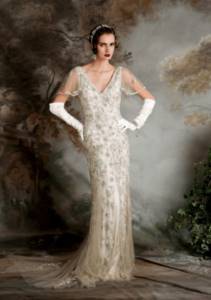
The outfit can be with a full skirt and a long train - a classic in its purest form for those who want to feel like a touching and luxurious bride. The length of the wedding dress can be any; slender, long-legged brides with no flaws in their figure will look impressive in a model that is short at the front, complemented by a long train at the back.
Puffed sleeves are the highlight of the retro style. In general, an outfit with sleeves, be it three-quarter length, wide and transparent or narrow and lace, looks amazing. Sometimes straps are used instead - their shape, number and width can vary in the most incredible ways.
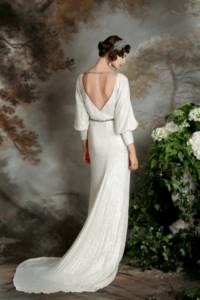
The styles are really different - with a multi-layered or lace skirt, narrow, with a spacious bodice, a low or slightly defined waist, a model narrowed to the knees and fluffy at the bottom. You can choose any one, focusing solely on your taste or listening to the advice of experienced representatives of the fashion world. The main thing is to correctly combine the chosen outfit with shoes, jewelry and flowers, only then will the retro ensemble be harmonious and complete.
Accessories
Well-chosen accessories help complete the retro look. So, in the 20s it was impossible to do without a string of pearls, a fur coat or a feather boa, and in the 40s and 50s natural pearls were replaced by beads made of artificial pearls.
You can complement the retro look:
- beads;
- brooches;
- hats;
- fur coat or boa;
- feather boa.
Advice! To choose the right accessories, decide on the time period for creating the style.
The hairstyle will also contribute to completing the look. It can be light waves, curls, updos, or backcombing. Among the accessories, choose an option that matches the retro style - hairpins, bows, silk scarf, ribbons, hoops, beads, headbands with feathers. It is also possible to remember the classic bride’s accessory - a veil, but it is more suitable for dresses in a vintage style.
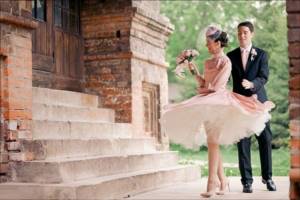
Accessories and flowers
Jewelry and accessories should be selected taking into account the era from which the dress is borrowed. Some recommendations for choosing the right “entourage” for a retro outfit:
- We take appropriate shoes, for example, shoes with a round toe or a jumper at the ankle.
- A belt with a brooch, a bright ribbon, a narrow bodice are perfect options for effectively emphasizing the waist.
- The veil can be of any length, single-layer or multi-tiered, with a veil. Many brides would not mind replacing it with a stylish pillbox hat or a delicate veil.
- The image of the newlywed can be favorably emphasized by gloves, bags, hair jewelry, and scarves. A retro handbag should match the outfit. Scarves, fur boas, muffs or boas will perfectly complement a winter vintage outfit.
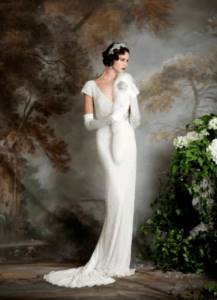
- You should be careful with jewelry. If real vintage items are hard to find, there is no need to replace them with modern variations. In this case, large beads or long strings of small beads will be enough to successfully complete the look.
- For a wedding in a retro style, a bridal bouquet made of artificial flowers, decorated with a large brooch, lace, and beads would be appropriate.
Recommendations
When choosing a wedding dress in a retro style, many will find step-by-step instructions useful:
- Decide what kind of wedding you will have: classic and elegant or modern and bright;
- For an elegant, classic wedding, choose one of the modern variations on a vintage style. Classic bodycon dresses from the 1930s or 1950s are also suitable;
- If you are planning a fun wedding, give preference to wedding dresses in the “Hipster” style of the 60s;
- Once you have decided on the style, you need to choose a dress in size, taking into account your figure. For example, tight dresses from the 50s are more suitable for girls with ideal proportions, and the rectangular silhouette of Gatsby-style dresses is universal;
- Complete the look with accessories. For example, if you have small or, on the contrary, large breasts, choose a Gatsby-style outfit with a cutout on the back, not on the chest, and use a boa.
Story
Content
The “vintage” direction usually includes a huge time period of 6 decades, each of which has its own distinctive features:
- The free 20s were a protest against imposed feminine details in outfits: the absence of corsets, voluminous cut of clothes with a straight back and skirt, closed neckline, low waist.
- The apogee of the grotesque and emancipation or the 30s. – minimalism of details in the dress, absence of any decor, an increasingly straight silhouette and a waistline lowered to the hips.
- The militarism of the 40s - shirt-cut outfits with a pronounced waist, a straight, voluminous skirt and an emphasized shoulder girdle were in fashion. The bride's image becomes as feminine as possible.
- The golden age of retro style – that’s what the 50s are called. XX century. Christian Dior and his iconic ideas excite the minds of fashionistas all over the world. Satin with a glossy surface, multi-layered skirts, airiness of the outfit - this is what distinguishes A-line dresses. Corsets, trains and floor-length veils are back in trend.
- The 60s and their fashion revolution. Clothes are becoming more revealing, and minis are breaking into wedding fashion.
- Eclecticism of the seventies or a combination of incongruous things. Wedding dresses boast original details: puffed sleeves, hundreds of flounces and ruffles, an unimaginably long veil, and so on. The tender and mysterious image of the bride is in favor at this time.
- The decline of an era and the “classics of the genre” are wedding dresses of the 80s. Here you can find the traditional canons of a newlywed's outfit - a long veil, airy sleeves, an unimaginably full skirt.
The variety of models for choosing a wedding dress in vintage style is simply enviable. Today, studios that help newlyweds organize a holiday offer ready-made scripts for stylized retro ceremonies: in the spirit of the Victorian era, the Great Gatsby, dudes, gangster America of the 30s. For each of them there is sure to be an original, authentic dress.
Accessories, hairstyle, shoes
When choosing shoes to match an ancient attire, give preference to a pair with a small heel. Vintage products are incompatible with stiletto heels, pointed toes, and wedge sandals. Shoes for a special event can be decorated with a satin ribbon or a fabric bow located on the leg.
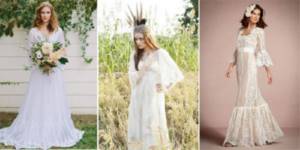
When playing a wedding in vintage style, you need to select accessories that match the theme. A small hat or veil will be a harmonious addition to your hairstyle. These decorations must be made to match the color and style of the dress. They can be decorated with beads, feathers, and pearls.
The headband is an elegant decoration for the bride's hair. It may vary in width, but is always decorated with lace. To emphasize the style of the set, you need to wear the headband in the middle of your forehead. The bolero will serve as an excellent decoration in cold weather.
A pirate veil with flowers on the sides or a beautiful hairpin can serve as a chic decoration for hair of any length. Also, don't forget about gloves. They can end at the elbow or wrist, and be decorated with satin flying and openwork inserts.
Beads with a small handbag are always appropriate. Such accessories can decorate any composition. To maintain the thematic concept, it is better to use artificial flowers. They can be decorated with feathers, beads, and brooches.
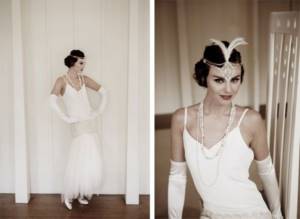
The most popular hairstyle for a vintage style would be a short straight bob with curled waves. Moderately bright makeup will help complement the look. All elements should emphasize the bride’s dignity and create a sophisticated, feminine look.
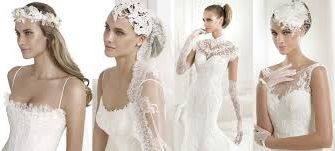
Vintage themes are becoming extremely popular among many girls. This is not surprising, because wedding dresses in the style of the last century look stunning. With their help, you can create an original image that emphasizes the advantages of the bride’s figure.
Wedding fashion of the 40s and 50s
The Second World War made its own adjustments to people's lives in all directions. Destroyed industries, men who had not returned from the front lines - weddings at that time were a rarity in themselves, and wedding outfits were simple and even everyday . Only in the late 40s did the wedding industry begin to gain momentum, and the middle of the last century provided girls with the opportunity to get married elegant and elegant.
Romance has returned to people's hearts and wardrobes. Wedding dresses of the 50s are midi skirts, fitted styles, fluffy bottoms and neat, even formal tops. The emphasis is not on the complexity of the cut, but on the use of expensive airy (taffeta) or, conversely, materials that hold their shape (crepe). Lace trimming is done on a moderate scale, but the sewing is chosen to be of exceptionally fine workmanship.
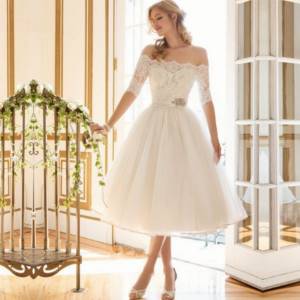
Wedding dress with retro patterns
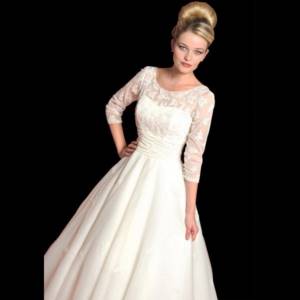
Photo of a Soviet era wedding dress
Wedding dresses of the 20s of the last century
The revolution took place not only in the political sphere of the country, but also in the fashion industry, and this could not but affect the outfits of fashionistas of that time. More and more often, modern brides are turning to the styles of that time: shortened models, very open and bold, appeal to the tastes of girls of the 21st century.
Nowadays, a retro wedding dress in the style of the twenties looks like a simple silhouette combined with expensive, original textured materials and luxurious decor. Currently, the fabrics chosen for such stylized dresses are airy and thin, matte or satin - chiffon, silk, satin. The lightness of the style is ensured by multi-layering and a bold combination of different textures of materials.
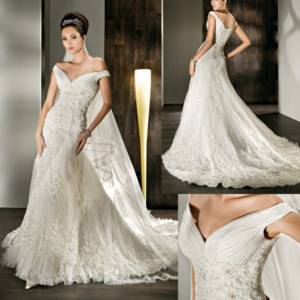
Wedding fashion of the 20s of the last century
The highlight of the bride's image of that time was a spectacular, rather deep neckline and a very low waist, literally down to the hips; often there was an asymmetrical hem that emphasized beautiful legs. The decoration must certainly be rich , otherwise the dress for the wedding ceremony will seem too simple: embroidery with pearls, beads or rhinestones, and decor with thin lace are actively used. Long large beads and massive brooches are recommended as accessories to maintain the retro style.
Last decade of the last century
By the end of the 20th century, the free wind of wedding fashion was slowly calming down, and brides were returning to the classic image of a fairy-tale princess . And this, first of all, is a traditional cut with bare shoulders, a defined waist and a full skirt. Crinoline and layered hemlines are coming back into fashion, with an abundance of lace decor, and color schemes are in shades of white (milk and ivory are beginning to appear on fashion catwalks).
The luxury and richness of the outfit, as before, is achieved through magnificent decor and expensive fabrics - any bride in a 90s-style dress looks like a true queen. An additional emphasis in the image is placed on a complex hairstyle, decorated with a medium or long veil.
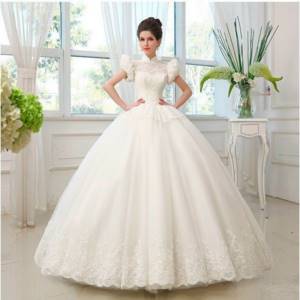
In the 90s of the last century, princess-style wedding dresses came back into fashion.
Antique wedding dress
The concept “ancient” takes us back two or three historical centuries . Wedding dresses of those eras were seriously different in style from modern ones, and the color schemes were most often not snow-white at all. Since weddings in those days were rarely of a love nature, but more of a commercial nature, the bride’s dress reflected the wealth of her family and had to correspond to the social status of her future husband. These are expensive, usually refined and expensive materials brought from abroad: silk, satin, corduroy, velvet.
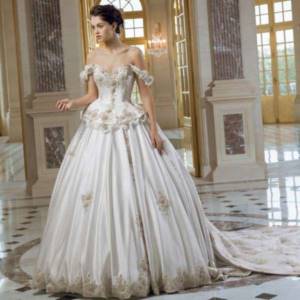
Photo of a 19th century retro wedding dress
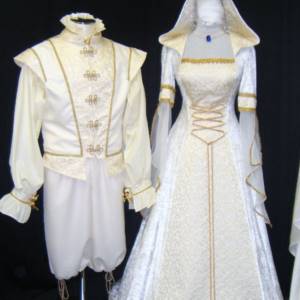
Wedding dresses in medieval style
Gold and pearl threads, the finest handmade lace, precious stones (emeralds, sapphires, rubies), and rich fur (mink or sable) were chosen as decoration.
The moral principles of that era dictated their own rules : dresses for the bride were closed, the chest and neck were not exposed, the hem was certainly “floor-length” and sleeves were of maximum length. The color of the wedding dress directly indicated the financial well-being of the bride’s family: materials for dresses dyed with natural pigments were expensive, and therefore only girls from a rich family could afford bright models in scarlet, pink or blue.
Natural colors of wedding dresses (milk, beige, natural linen) remained the lot of poor brides; fur decor consisted of hare or fox skins. When choosing an antique dress now, it is worth considering these symbolic moments.
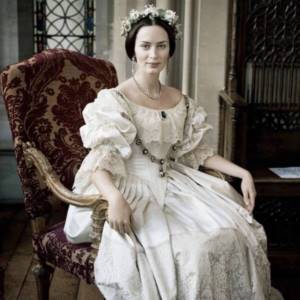
Photo of a wedding dress in a medieval style
In families of modest financial means, wedding dresses were made with the expectation that in the future such an outfit could be worn on any significant occasion. By modern standards, such a wedding dress will seem too practical and rustic , so designers usually use old styles, but make them from expensive textured fabrics with spectacular decoration.
